
What you’ll need to make your own curtains
Before you sit down to sew, make sure you’ve got everything you’ll need.
· · Fabric
· A sewing machine (any sewing machine… all you need is a straight stitch;-)
· Thread, scissors, pins, marking chalk
· A tailor’s square (or an ordinary yardstick)
· An iron
In terms of sewing skills, as long as you can manage a nice, straight stitch you’ll be fine. Curtains are all about long, straight lines. Plus, if you’re sewing with linen, this project will be a piece of cake – linen is just so easy to handle.
This tutorial can come in handy even if you’re just shortening store-bought curtains. In that case, trim off the bottom hem (or rip out the stitches) and make a new one at your desired length. (Skip forward to the last step of this tutorial.)
Choosing fabric for curtains
If you’re new to sewing, we recommend starting with linen (see our curtain fabrics). Not only does it work well in most interiors, it comes in a wide selection of colors from muted, earthy tones to deep, vibrant hues and is relatively affordable. When choosing linen for curtains, anything from a medium (150 gsm) to a heavy weight will do. A medium linen will have an airy look and let in more daylight, especially lighter colors, while heavier linens keep out more of the sun’s rays. (That said, if it’s blackout curtains you’re after, you’ll need a specialty fabric.)
An added plus is that linen is easy to care for and, unlike synthetics, doesn’t generate static electricity or attract dust.
For silk fabric curtains select a nice noil, matka, or dupioni (you can wash dupioni for a softer drape). For diaphanous, sheer panels try voile and for a tony, exclusive interior, you might consider brocade.
The well-dressed window
It is worth taking a little time to understand the fabric that you are working with and think about how to make the final product behave the way you want it to. A sheer panel will take a narrower hem. One foolproof way to make neat gathers at the top of your curtain is to use gathering tape – get it at any fabric store. If you want your drapes to hang demurely in place (as opposed to billowing romantically), sew a weighted lead cord into the lower hem or place lead penny weights in the corners.
Sewing curtains from voile, or any fine silk, requires a fair amount of precision and patience and is not a project for the absolute beginner. If you haven’t worked with these fabrics before, it’s a good idea to try them in a smaller project first.
How much fabric will you need for making curtains?
Your final curtain length depends on the height of your window and where you want the bottom edge to fall. Curtains usually come either to the window ledge or to the floor. When calculating length, don’t forget to include a hem allowance at both the top and the bottom – how much will depend on how you hang the curtain and how broad you want the lower hem to be. If you want tab curtains, don’t forget to add fabric for the tabs. And, of course, allow for 3–10 percent shrinkage.
Your final width should be about one and a half times the width of your window (or your curtain rod, which is generally a bit wider than your window). For curtains with an ample gather even when weighted, use twice the width.
For decorative panels that will hang beside the window without ever being drawn, you can go narrower.
To save yourself a little effort, download our curtain calculator. It will tell you how much fabric you need (and it’s free for personal use).
An example
Let’s say your window is 4 feet wide, that’s 48 inches, and the curtain rod is 60 inches (6 inches on either side). We want two curtain panels, so divide in half to get 30 inches. Multiply that by 1.5 and 45 inches is your curtain panel width. So you will need two strips of fabric at least 45 inches wide.
Hanging your curtains – 4 easy options (plus 1)
Before you start sewing – before you even order fabric – you will have to decide how you want to hang your drapes.
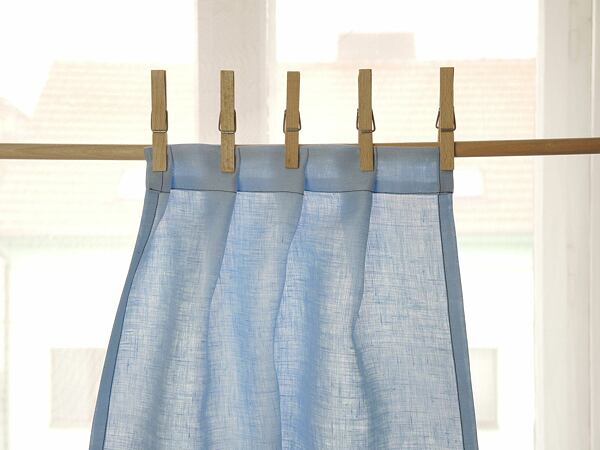
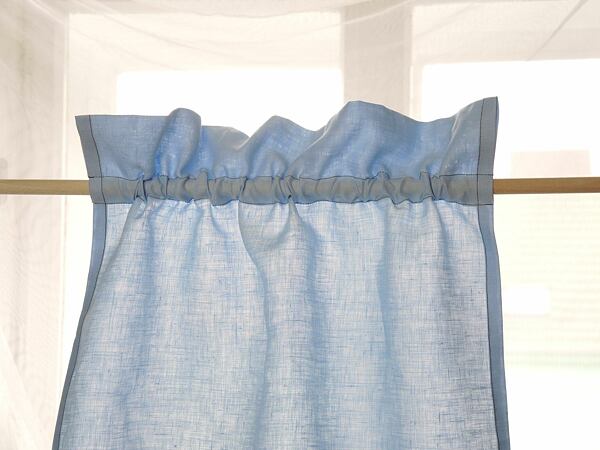
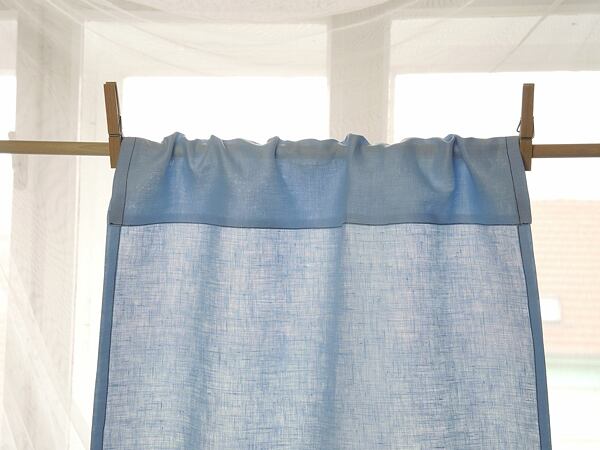
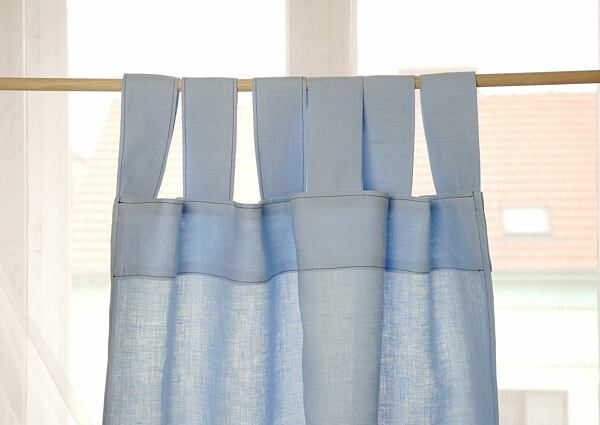
Ring clips
The simplest option is to make a wide hem at the top and then just use ring clips to hang. No other adjustments are needed. Dead easy ;-)
Rod pocket
More of a tunnel than a pocket really, this is another easy option. Simply fold over the top edge to create a tunnel for your curtain rod to run through. This works best if you have a nice thin, smooth rod that the fabric won’t catch on when you draw your curtains.
Curtain hooks
To use curtain hooks, sew a length of gathering tape along the top edge of the curtain in the back, and then hook those little devils onto it. Gathering tape comes in various widths and weights for working with a variety of curtain fabrics. If you have sheer curtains, choose a sheer tape that will be less visible.
Tabs
Tabs mean a little more work at the sewing machine, but they slide along the curtain rod well and don’t require any extra hardware. On the other hand, if you sew them on at the very top of your curtain, the rod will be exposed and the curtain won’t come all the way to the ceiling – a gap will remain at the top.
Eyelets
We include curtain eyelets on this list for good measure but most of us don’t have the equipment necessary to work with them at home, so they aren’t dealt with in this tutorial. To apply these large, metal eyelets you need a special press.
Before you begin
If you have chosen a washable material that requires pre-shrinking (we’re looking at you, linen) wash your fabric first. You will find care information in the descriptions for all of our fabrics – some silk can be washed and all linen should be.
Sometimes fabric can twist a bit after washing – the warp and weft no longer form a perfect right angle. To prevent this from happening, straighten the fabric with your hands before hanging to dry.
After washing, trim off the selvage (the finished edge) from your fabric. It is tempting to leave it there and use it as a lazy hem, but it will come back to haunt you. For one thing it really doesn’t look that great, for another the selvage tends to shrink more than the rest of the fabric (it’s more densely woven) and that makes your curtains twist.
When sewing curtains, use ordinary polyester thread the same shade as your fabric (take a scrap with you when you go to buy it). Put a universal size 12 or 14 needle in your sewing machine.
Sewing curtains
For most curtains you want to start with the sides and then finish the top and bottom. The exception to this rule is when you’re making curtains with tabs – there you start with the top.
In general, you’ll simply fold the hems over and sew with a straight stitch. That’s all there is to it. You won’t need pinking shears unless you are working with a fabric that frays an awful lot (like dupioni or some brocades), in which case, trim all around with pinking shears before continuing.
Finishing the sides
Finish vertical edges for your curtains with a half-inch hem, or even narrower. Fold over about a quarter inch first and then fold over again to hide the cut edge inside a half-inch hem. The exact width isn’t so important – just try to keep it uniform. Press the hem before you sew, fix it with pins, and then put it in your machine and sew along as shown. Hint: Sew from the back so that you can keep an eye on the edge of the hem.
Don’t worry if the edge twists a bit. Just straighten it out with a steam iron.
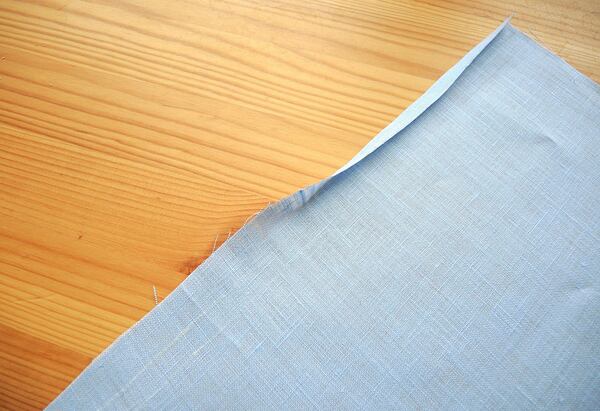
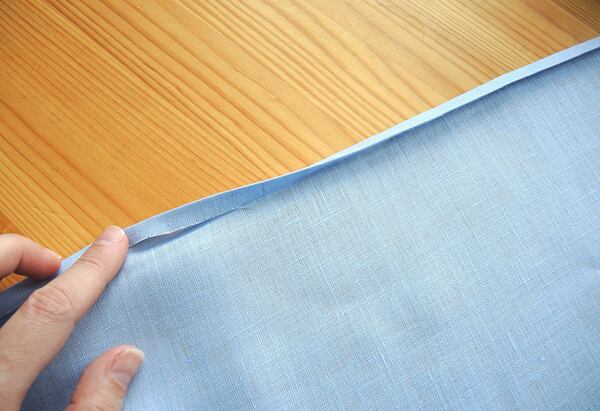
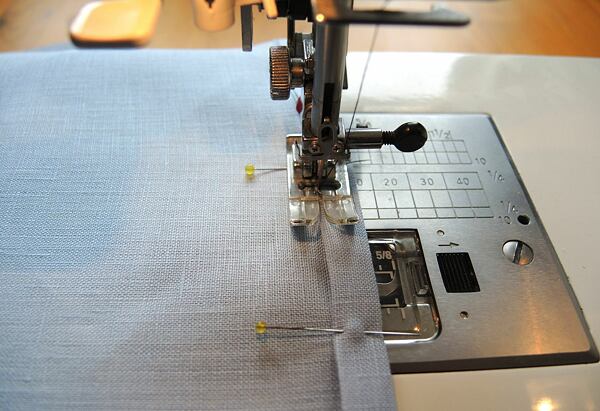
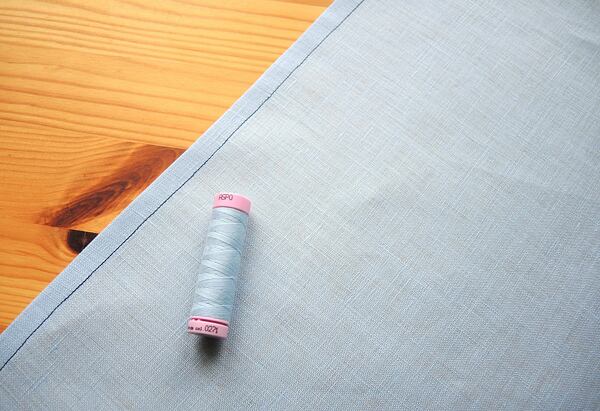
For this tutorial, we used a dark blue thread so that the stitching would be easier to see in the pictures. The photo above shows the sort of blue that we would use if it were the real deal. If your thread is a good match, your seams will be nearly invisible. Don’t use a contrasting thread or every little mistake will pop out at you.
Finishing the top of the curtain
Sewing the top edge is a lot like finishing the sides, except the hem is wider. First fold over about a half inch, and then fold again to whatever width you will need for the type of curtain you’re sewing (see below).
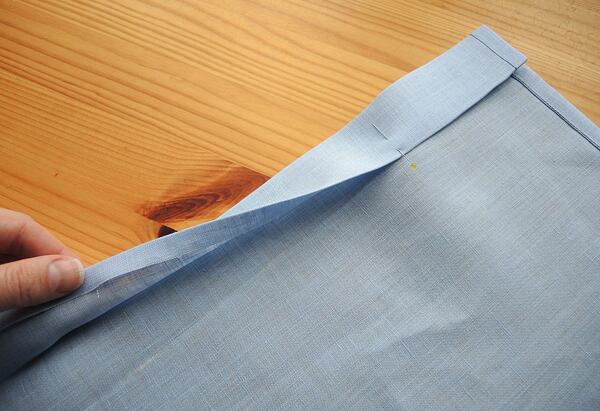
Ring clips
If you want to use ring clips to hang your curtain, make your top hem about 2 inches wide. Fold, press, and sew it near the edge.
Now all you have to do is attach the ring clips. Space them out evenly every 3 or 4 inches and your curtain is ready to hang.

Rod pocket
The next option is hanging your curtain with a rod pocket. This is pretty much the same drill as sewing the top edge for ring clips, except that the upper hem will be wider to make room for the curtain rod. For a thin curtain rod make a 3-inch fold-over, for a thicker rod, 4 inches. A very thin rod for a window flounce may only require 1 ½ to 2 inches.
If you want to fill the space above the curtain rod, making a top ruffle is easy. Simply make your initial hem wider and then sew it twice – once at the bottom edge and again higher up to form the ruffle above the rod pocket.
Curtain hooks
If you will be using curtain hooks to hang your curtain, adjust the width of your top hem so that the upper edge of the curtain will hit where desired – you want to cover the rings that your curtain hooks hang from. The hem width is determined by the width of the gathering tape you are using, how big your hooks are, and the ring diameter.
Fold over the edge and pin the tape to it.
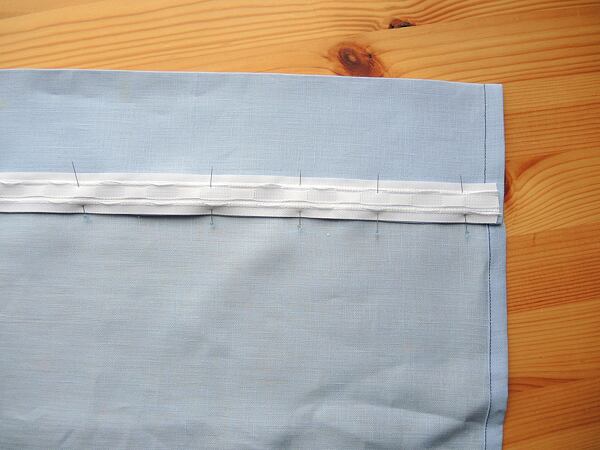
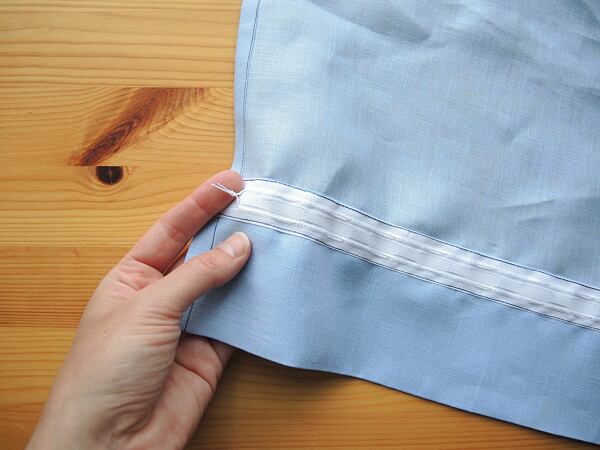
Sew the bottom edge of the hem and the edge of the tape all at once. Then sew the other edge of the tape in place. Carefully pull tape threads out just a bit and knot them together on the sides so that they won’t pull through. (If they do come out, you can rethread them with a dull-pointed needle.)
Pulling the thread on one side of the curtain will make gathers. To hang them, you gather them first, then attach curtain hooks at regular intervals on the tape.
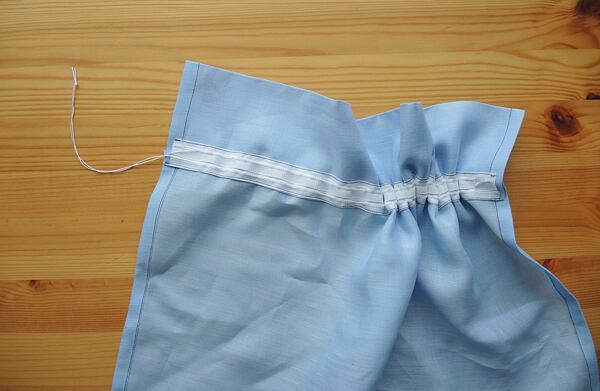
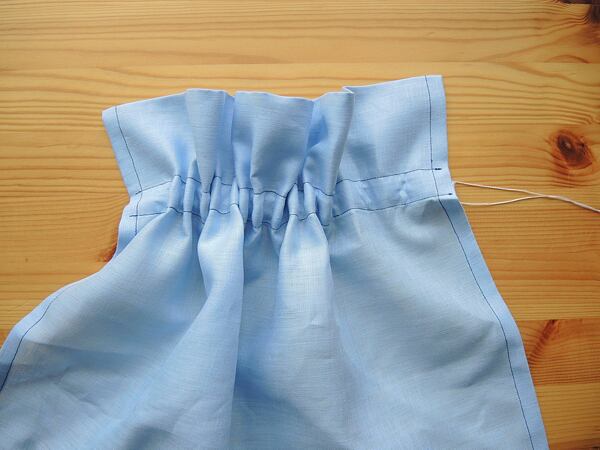
Tabs
If you are making tab curtains, remember to allow extra fabric for the tabs. Each will be about 2 inches wide and 4 inches long. Space them evenly 3 to 5 inches apart – for a 55-inch curtain that’s 8 to 10 tabs. Now add it up – for each tab you need a 5 by 10 inch strip of cloth, so for 20 tabs you need 20 inches of cloth 50 inches wide.
Fold the strip in half lengthwise, face side in, and pin it, but don’t iron it yet. Sew about 3/4 inch from the edge.

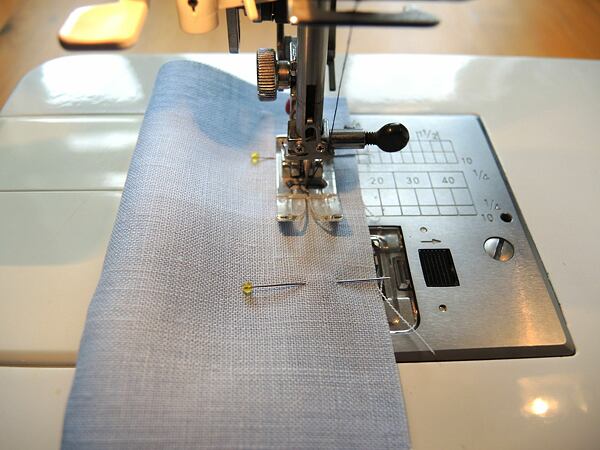
Turn the tab right side out, arranging it so that the seam runs down the center, and iron it flat. You can finish the edges by sewing along them if you like, but you don’t really have to.
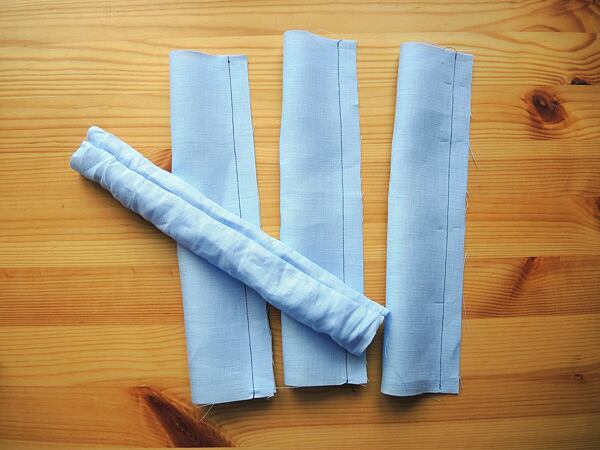
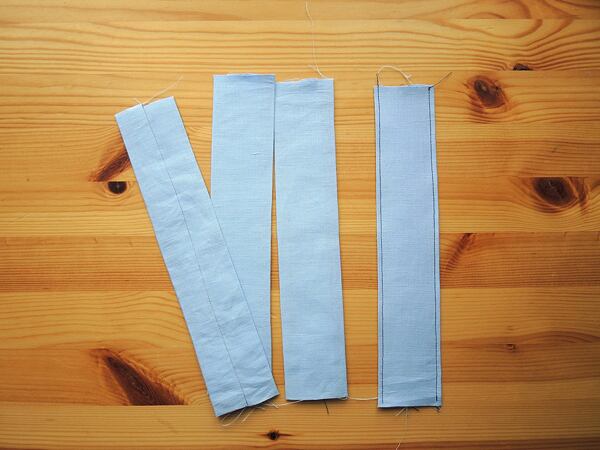
Lay your curtain panel face side up on the table and pin the finished tabs along the upper edge as shown. Do not place tabs flush to the side edges – leave about an inch for the side hem (see photo). Now we’ll add a strip of fabric to hide the tab ends on the back.
Take a strip of fabric roughly 3 inches wide and as long as your full panel width. Align it with the upper edge of the curtain, covering the cut ends of the tabs, and pin it in place. Sew all along the top edge through all three layers roughly ¾ inch from the edge, going slowly and looking out for pins.
Now it’s finally time to hem the sides. Turn over the curtain panel so that is lying face side down with the tabs extended and the cover strip unfolded as if it were a continuation of the whole panel. Now fold the side hem twice over and do the same along the upper edge of the cover panel. Next, fold the cover panel down to hide the ends of the tabs (keep the side hem in place). Press with an iron and pin all edges down. (See photos below for help.)
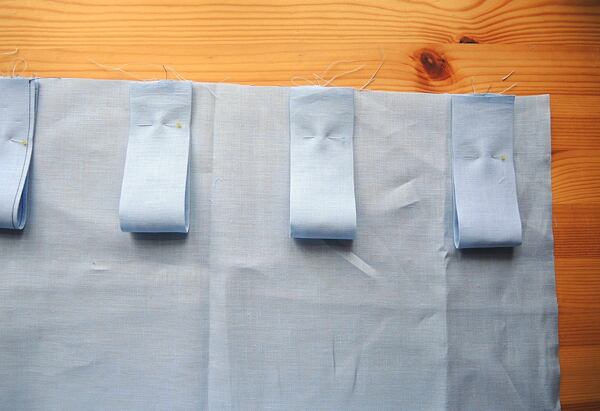

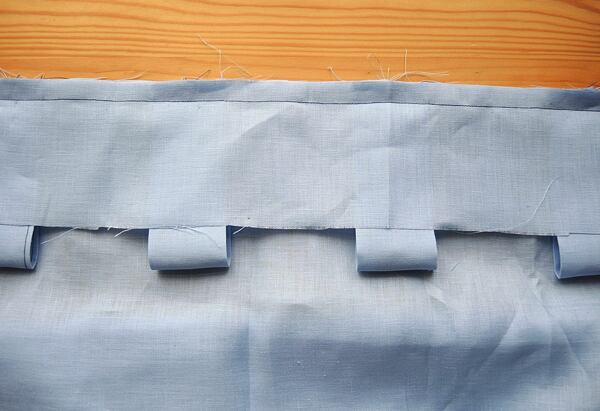
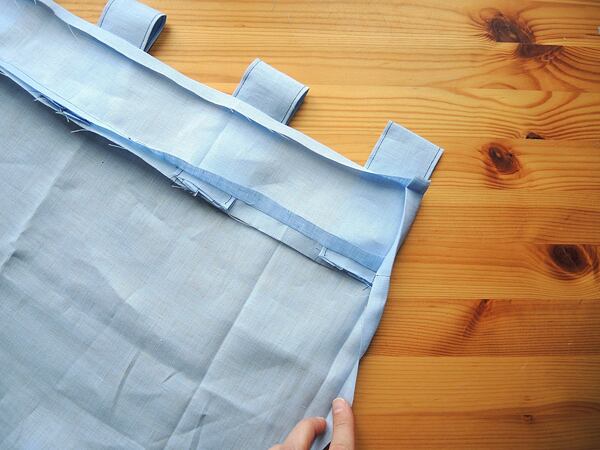
Now it’s time to sew everything in place. Start with the sides. Then sew along the cover strip. Finally, sew all along the top of the curtain, where the tabs emerge, for reinforcement.
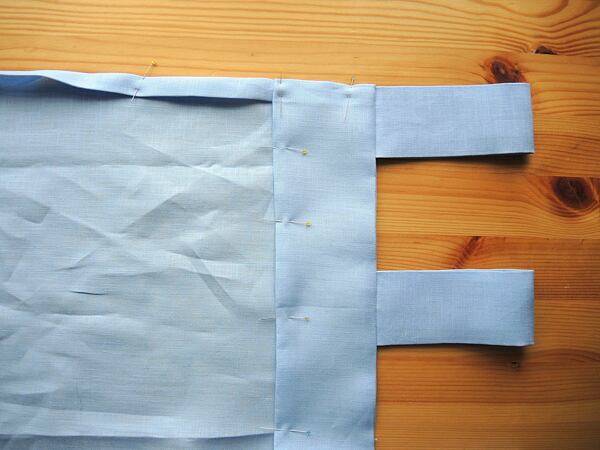
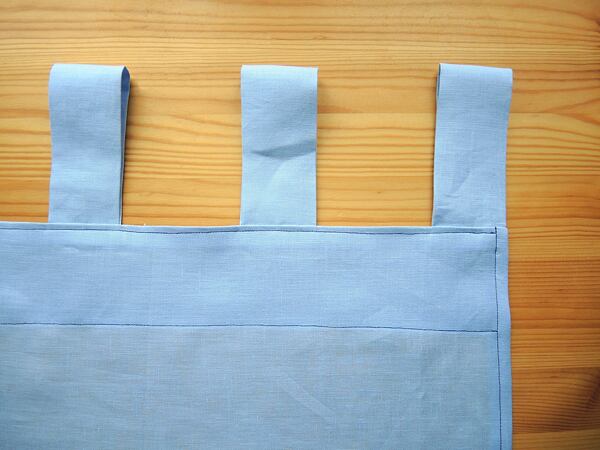

How to hem the bottom of the curtain
The bottom of the curtain can be finished with a simple hem. Decide how wide you want it – the longer your curtain, the wider your hem.
The hem adds weight, which helps your drapes hang straight. For a full-length curtain that reaches from ceiling to floor, you may want anywhere from 4 inches to a foot. For shorter curtains, a couple of inches may be enough, or even a narrow hem like the one we used along the sides.
The width of the bottom hem is really a matter of taste. If you are not quite sure what you want, just cut your curtain panel a bit longer and try pinning it at various lengths. You can always cut off the extra fabric.
It’s a good idea to pin the bottom hem while your curtains are hanging. Stand back to eyeball it. If you don’t like what you see, you can adjust the length. It’s a bit more work, but definitely worth the effort.
If you want to weigh down the bottom of your curtain so that it won’t move in a breeze, you can get curtain weights at any fabric store and simply insert them in the bottom hem. Options include cord-covered lead chains and special penny weights. You can also pick up a handful of flat washers (the kind they pack with DIY furniture) at the hardware store. Just remember to put any weights inside the hem before you sew it up!
Sewing the bottom hem is the same as sewing the top for ring clips or a rod pocket – fold over a bit at the edge, fold again, press, pin, and sew.
And that’s it! Sewing curtains is really just a series of long straight seams. If you can work without interruption, you’ll have them hanging the same day.
Planning to make your own curtains? Got a nice set hanging already? Share your plans, success stories, and epic fails in the comments!


Comments(1)